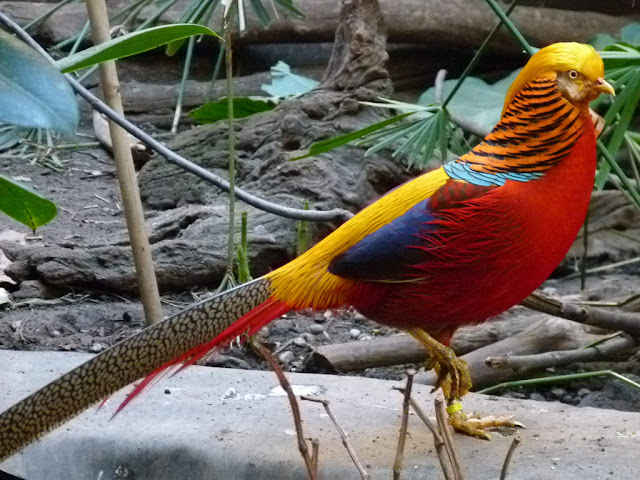Scientific classification
Kingdom: Animalia
Phylum: Chordata
Class: Aves
Order: Galliformes
Family: Phasianidae
Genus: Chrysolophus
Species: C. Pictus
Binomial name: Chrysolophus pictus (Linnaeus, 1758)
Introduction
The Golden Pheasant is a brightly coloured bird from central
China. Some feral populations are established in UK. This species is common in
captivity, but they are often impure specimens, result of hybridization with
the Lady Amherst’s Pheasant. Several mutations of the Golden Pheasant are seen
in captivity, with different plumage pattern and colours. The wild type is
known as “Red Golden”.
The wild Golden Pheasant is living in the mountains of
Central China, and often occurs in dense forests. This shy bird usually hides
in dense forested areas. This behaviour could be a kind of natural protection
of their bright-coloured plumage. Actually, these bright colours could be
susceptible to become paler if exposed to sun for long hours during the day.
The Golden Pheasant is a very popular species.
Characteristics
Male and female Golden Pheasants look different in
appearance. Males measure 90 – 105 centimetres in length with the tail making
up two thirds of the total length. Females are slightly smaller measuring 60 –
80 centimetres in length with the tail making up half of the total length.
Their wingspan is around 70 centimetres and they weigh around 630 grams.
Male Golden Pheasants can be easily identified by their
bright colouring. They have a golden crest tipped with red which extends from
the top of their heads, down their necks. They have bright red underparts, dark
coloured wings and a pale brown, long, barred tail. Their rumps are also
golden, upper backs are green and they have bright yellow eyes with a small
black pupil. Their face, throat and chin are a rust colour and their wattles
and orbital skin are yellow. Beak, legs and feet are also yellow.
Female Golden Pheasants are less colourful and more duller
than males. They have a mottled brown plumage, pale brown face, throat, breast
and sides, pale yellow feet and are more slender in appearance.
Habitat
Their natural habitats are dark young conifer forests with
sparse undergrowth.
They feed on the ground on grain, leaves and invertebrates
(= animals without internal skeleton, such as insects, larvae, earthworms,
millipedes, snails, spiders), but roost in trees at night. Whilst they can fly,
they prefer to run: but if startled they can suddenly burst upwards at great
speed, with a distinctive wing sound.
Although they can fly in short bursts they are quite clumsy
in flight and spend most of their time on the ground.
Lifespan
5 – 6 years
15 – 20 years under human care
Breeding
The 5—12 chicks can feed themselves upon hatching.
The golden pheasant has a colorful courtship display that
rivals even the famous birds of paradise. The performance is heightened by
squeaks, clicks and whistles from the male, culminating in a snakelike hiss as
he flicks up his golden cape and spreads his tail in the air Most males pair
with only one female, but the most successful performers acquire harems of up
to eight hens. The female, whose nest is a simple scrape, is a devoted mother
Even though her nest is well hidden, she sits continuously for more than three
weeks, surviving on raindrops and dew. Once hatched, her chicks follow her from
the nest. In two weeks they can flutter up to roost in trees.
Diet
Golden Pheasants mainly feed on the ground on grain,
invertebrates, berries, grubs and seeds as well as other kinds of vegetation.
Behaviour in the Wild
The Golden Pheasant feeds primarily on plant materials such
as berries, seeds, leaves and tender shoots of shrubs and bamboos, and
rhododendron flowers. But it may take spiders and various insects too.
During the day, it forages on the ground by walking slowly
and pecking. It usually feeds in the early morning and the late afternoon, but
it may move all day round. At night, it reaches a nightime roost in very high
trees.
During the breeding season, the male displays and enhances
its superb plumage by posturing and strutting, and performing various movements
in front of the female. During these displays, it spreads his neck feathers
(ruff) over head and bill, like a cape.
Fun Facts
- In China people think of Golden Pheasant as a sign of good luck, best fate and prosperity.
- Although they can fly in short bursts, they are quite clumsy in flight and spend most of their time on the ground.
If You Like, Please Share with Your Friends..



















Thanks For Sharing. Check My Post......
ReplyDeletePictus Catfish (2021): Unlimited guide care, food, breeding, size more
Pictus catfish size This pictus catfish is silver in color with many black spots. It has transparent fins and white chins. When its body is…
click here